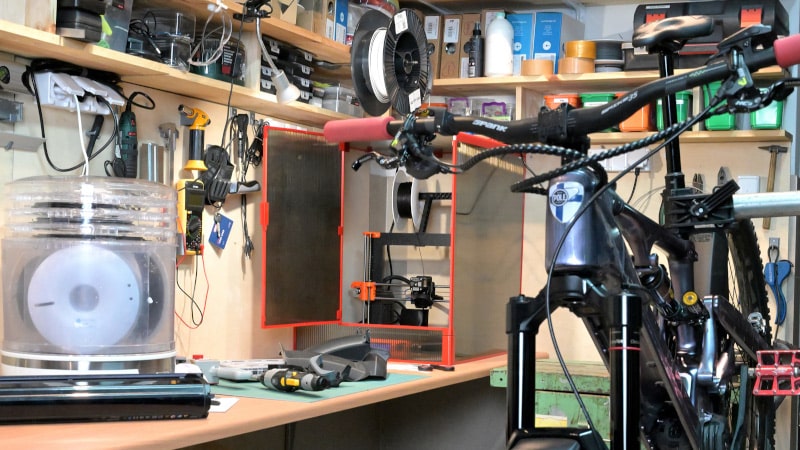The slogan “startup” is very often associated with a technology company (sometimes fintech) that builds software tailored to its needs inhouse. It seems that there is no place for the use of low-code platforms in such conditions. They offer great business opportunities, but due to their generic nature, they also introduce certain limitations in the implementation of the required application. It may be unacceptable for a startup.
There is a lot of truth in this, but only for new ventures that focus strictly on software.
A large proportion (if not most) of startups operate in the world of innovative but physical products or services. In this case, the software only supports the company’s operation, and its implementation should not be too absorbing for the founder. On the other hand, in many cases, we are talking about an innovative and non-standard production process, which makes ready-made ERP software useless.
This is where the low-code platform VSoft archITekt comes in handy.
Case study
Let’s consider a specific example. The company enters the bicycle parts market with products manufactured in 3D printing technology. Its advantage over other mass producers is the possibility of full personalization of products. In turn, it wins with typical companies offering 3D printing services offering ready-made ideas and projects, which from the customer’s point of view are real products. To bypass middlemen, it sells products directly to bike owners who can place an order through the site.
Thus, the key activities of the company are the creation of new projects, their production and direct customer service.
Where’s the catch?
The company operates without external capital, the owner is the main designer and contributor. Since venture is at the stage of early R&D, everything is successfully done by hand. This is the stage in which new ideas are validated on the market, there is not yet a wide range of products and the cooperation comes down to individual customers. The fact that all processes are “in the head” of the owner and not the IT system is an advantage, you do not have to invest too much in ideas that may fail anyway.
The situation changes dramatically when the first product “grabs traction”. Orders are starting to flow faster and faster, and conversations with customers, which until recently were a great source of inspiration, are now becoming deadly time-wasters blocking further development. It is no longer possible to simply provide high-quality customer service without having a registry and proper “reminders” regarding orders.
Keeping records in the proverbial “Excel” helps to somehow control the situation but does not solve the problem of amount of time consumed by manual operation.
The situation becomes an order of magnitude more complicated when new products are introduced to the offer. Each of them means dedicated print files, printer configuration, description of the assembly method, etc. The owner is no longer able to cope with it himself, he must hire employees. And they need to be given precise knowledge about the processes, it cannot be just “in the head” anymore.
It is necessary to implement software that will help in managing the processes.
At first glance, it seems that the easiest solution is to use a ready-made ERP system combined with CRM, preferably in the cloud. However, such a system must be chosen, which takes time for product development. On the other hand, an overly hasty choice may lead to a situation in which poorly identified constraints will block the needs of a growing company in the future. Additionally, the method of production and customer service are distinguishing features and elements of a competitive advantage. Bending the processes to the out-of-the-box software can spot the idea of the entire business. Bypassing the limitations by manually handling custom items is another half-measure.
The vicious circle is closed.
Low-code – the solution
If there is no ready-made software, can it be created from scratch? At first glance, this idea looks ridiculous. Since the owner of a startup absorbed in business does not have time to select and implement ready-made software, how is he supposed to be on a dedicated project?
It turns out that thanks to the low-code there is a method in this madness. Not only is it possible, but it may turn out to be the optimal solution. All thanks to two unique low-code features:
- If the founder moves freely in the world of CAD design, 3D printing control software, was able to create a website and configure a payment platform himself, then he certainly has the competences of Citizen Developer, so he will also be able to use the low-code platform by himself.
- Thanks to the flexibility of the platform, there is no need to build all the processes at once. You can start with a small seed and then expand or modify the app as your growing business needs.
An adventure with low-code in practice
The starting point in this case is when a company has a website through which customers can order a product. Clicking on the link leads to the already prepared basket in the payment platform, where you can complete the shipping details and pay. This is where automation ends.
Customer data must be manually copied to a local XLS file, invoices must be issued in the cloud ERP, communication with customers must be carried out via e-mail or social media, and the shipment recorded in the application provided by the carrier. The printed invoices are also the “order queue” based on which the production is carried out. Customer data are copied manually several times between different systems.
The owner decides to implement the new application in his spare time in the evenings. Let’s check how much he can do in a symbolic week with the use of the VSoft archITekt platform. Each of the evenings is the next stage of automation.
Evening 1 – Customer and order registry
The first and easiest step is to migrate the XLS file to the application created in the platform. By the way, it is possible to reorganize and extend the flat data model from the file, and thus to separate customer data from orders as well as to introduce a seed catalog of products. Using data model and GUI modules, an application is quickly created with a list of customers, orders, and products.
The created data structures can be pre-loaded with the previously used XLS file, thanks to which you can avoid another manual copying of the data of several dozen customers who have already placed orders. As a result, we get a transparent register, from which it is clear what who, when ordered. There is also no problem with many orders from one customer and various combinations of ordered products.
We haven’t saved much time yet, but the risk of mistakes and errors has dropped drastically.
Evening 2 – Automation of order receipt
The created register is the heart of the service system. Now we can add further stages of the process to it. The first is just taking the orders. In the discussed case, the Stripe platform was used. It provides the API that allows for integration. Another evening spent with the archITekt platform results in the creation of processing packages that read the data of new orders via API and enter them into the register. There is no manual copying and no fear that any order will be missed anymore.
We are starting to eliminate unnecessary time wasters in the form of manual data copying.
Evening 3 – Automated invoicing
The startup’s business model assumes a strictly defined, one way of settling accounts with clients. Therefore, it does not require any extensive ERP system capabilities, but invoices should be issued automatically without the need for additional operations or data copying.
The document generation module comes to action. Using the Word editor, you can create an invoice template that not only contains all the formal elements but is fully consistent with the assumed visual identification of the company. Invoices can be sent to the client or printed out in bulk at the end of the month for submission to the accounting office.
Here you can feel relief and have more time for talking to customers and R&D.
Evening 4 – improving shipping
The last area where manual data copying can be eliminated is the shipping of products. Nowadays, carriers (e.g. Poczta Polska), apart from providing an application in which you can register a shipment in advance, also provide the possibility of connecting to the API so that the registration of shipments takes place automatically. We take advantage of this by creating further processing packages that close our order handling. Now we have all the data in one place and there is no need to manually copy them.
From now on, we gain more time for marketing, and we get more and more orders ![]()
Evening 5 – Implementation of the service process and automation of communication with customers
There are so many orders now that it’s time to implement a formal service process. More precisely, to model it in the application, because the process itself has long been thought out by the owner and functions from the beginning, which is certainly reflected in the form of order statuses. Then why do more? Thanks to the modeling of the process in the system, it is possible to monitor the course of the process and thus automate the making of standard decisions and actions. For example, if the date of the planned production is delayed by more than two days, the customer should be notified of this, if the shipment has not been delivered for more than two weeks, the matter must be escalated with the carrier. Automating the process removes from the owner the need to remember all of this.
What has been in memory so far is enough to draw diagram in the processes module and connect it to the existing structures. Moreover, decisions can be followed by automatic actions such as customer notification. The document generation module enters the action again, with the help of which you can create graphic templates of e-mail messages. Thanks to this, all standard communication doesn’t require manual work anymore and the owner can focus on those cases where an individual conversation with the client is required.
More time devoted to R&D results in new ideas and products.
Evening 6 – implementation of the product development process
The production of parts on demand, using 3D technology is quite a specific business. As I mentioned before, each product is associated with project files, printer configuration, additional elements, assembly instructions etc. In addition, products evolve over time much faster than in the case of mass production, so that sometimes one version of the product only reaches a few customers. When the number of products on offer grows to several dozen, managing them becomes a real challenge.
But again, we can model the product development management processes in our application. Thanks to this, we gain not only a convenient tool for product management and the R&D process, but also smooth integration with orders and other processes (e.g., complaints). On the one hand, it is clear what exact products each customer ordered, on the other hand, from the product side, you can collectively view information about customer opinions about the product or the number of complaints.
Development accelerates, it is no longer possible to act alone.
Evening 7 – production support processes
The final touch of the automation of the startup’s operation is the support for the production itself.
In the case of early R&D, there is no such need, each prototype is made in just a few copies. However, when there is a stream of several dozen parallel orders per week, production must be planned for days or even weeks ahead. The number of machines is also growing, and it becomes extremely important to precisely plan production with a breakdown of individual printers. Customers can accept the long waiting time for the product, but they cannot bear the surprises in the form of unreliable information and delays.
Accurate prediction of the time devoted to production and the dates of subsequent “windows” for orders requires considering many factors and implementing an original algorithm. It is possible to create it in the application thanks to the algorithms module of the archITekt platform, where the owner draws all the dependencies that result from his expert knowledge.
With planned production, it is a formality to create appropriate screens and views that allow you to monitor the process from the point of view of individual devices. The screens built in the GUI module are responsive and conveniently displayed on mobile devices. Thanks to this, the list of other elements for production can be checked directly at the machine stands. The same applies to instructions and assembly stations.
Summary
In the case of a startup, especially one that does not have external financing, automation allows you to save the owner’s expensive time. With further growth and the need to hire employees, it drastically reduces the time of their training and the amount of work required to achieve the expected results. The presented processes, in their basic form implemented in seven evenings, are just the beginning of the road. They can be expanded in terms of complexity as well as new ones added in terms of marketing, cooperation with partners, sales campaigns, and others. The principle remains the same, first the process is created and then modeled using the low-code platform. Of course, this approach does not guarantee that we will have good processes in the company – they will be what we define them.
However, it will allow us to avoid bending the business to ready-made tools available on the market, and the built application will keep up with the development and new ideas.





